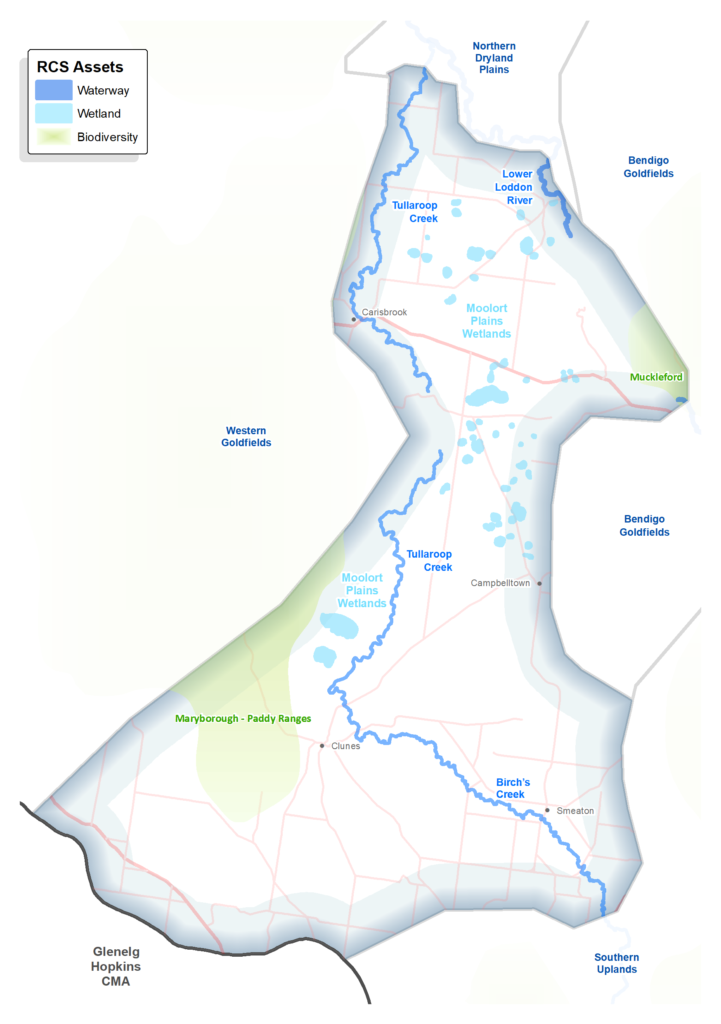Introduction
The Upper Loddon Plains is within the traditional lands of the Dja Dja Wurrung people.
The area is located on the upper Loddon, within a declared special water supply catchment area, and includes Cairn Curran and Tullaroop Reservoirs that provide irrigation supplies to downstream users. This area has fertile volcanic soils and has been extensively cleared for agriculture. Agricultural land use is a mix of dryland cropping and grazing, with some irrigated areas along the Loddon and in potato growing areas around Smeaton (groundwater). The township of Clunes is located centre of the area and has been earmarked for some growth.
Key environmental assets within this area include the Loddon River, Birch’s Creek and the Moolort Plains wetlands. A significant program was completed several years ago to protect many of the highly valued Moolort Plains wetlands.

A snapshot
| Aspect | Description |
| Key partners | Traditional Owners: Dja Dja Wurrung. DELWP, Parks Victoria, Trust for Nature and Agriculture Victoria. Local Government: City of Ballarat, Hepburn, Central Goldfields shires. Landcare Networks: Upper Loddon and Avoca. Water Corporations: GMW (rural) Central Highlands Water (urban). |
| Socio-economic | Moderate socio-economic disadvantage. |
| Bioregion | Victorian Volcanic Plain |
| Native vegetation cover | Relatively low proportion of native vegetation. The Land Cover Time Series data for the period 2015-19 showed that native vegetation of some type, covered only 22% of this area. |
| Rural residential or agricultural | Mix of agricultural and rural residential. |
| Agricultural land use | Mix of dryland cropping and grazing, with some irrigated areas along the Loddon River and around Smeaton (groundwater) The Land Cover Time Series data for the period 2015-19 showed that pasture (not native) covered covered 42% and dryland cropping covered 28% of this area. |
| Soils and land use overview | This land is in stark contrast to the adjacent Southern Uplands to the east and the Western Goldfields to the immediate west. It owes its origin to extensive volcanism that occurred repeatedly throughout the Quaternary period (the past 2.6 million years). The terrain largely comprises a basaltic plain frequently interrupted by extinct volcanoes. Volcanic eruptions have delivered a legacy of basalt flows and scoria cones. Ancient valleys have been infilled with basalt flows forming extensive plains. Well-drained soils formed on the basalt are deep, red, very fertile, and well-suited to horticultural pursuits. This is good potato growing country. Where the soils are less well drained heavier grey soils prevail that afford greater challenges where the goal is to build and maintain soil structure. Fresh groundwater found within the basalt flows is a big asset in the basaltic lands of the Upper Loddon Plains particularly where the water supports the potato industry. Rainfall is quite high relative to the rest of the region. Maintenance of soil structure and pest plant issues are the main farming challenges. |
Current and future challenges
The Upper Loddon Plains has and continues to face many challenges including:
- Climate change is affecting flows in the unregulated Upper Loddon River placing significant pressure on the aquatic ecosystems and the water resource outlook in irrigation reservoirs (Cairn Curran and Tullaroop).
- Water quality continues to be a concern, with significant and frequent Blue Green algae outbreaks in Tullaroop Reservoir.
- There is a low proportion of remnant native vegetation in this landscape.
Opportunities
Key opportunities for the Upper Loddon Plains include:
- This area has been identified as having high carbon potential, carbon markets could be leveraged to fund large-scale revegetation projects and improve habitat connectivity across this landscape.
- Implementation of Integrated Catchment Management projects to protect and enhance this catchment, improve climate resilience, water quality, etc.
Priority directions
Priority Directions are covered in more detail under each theme – those of relevance to the Upper Loddon Plains include:
Priority directions
- Continue to build partnerships with Traditional Owners towards self-determined participation and leadership in water and biodiversity planning and management.
- Deliver community-based participatory programs that build the capacity of land managers/holders, to improve land health.
- Continue to support the collaborative development and implementation of Integrated Catchment Management projects.
- Work together to develop place-based climate change resources for landholders and managers, to inform adaptation.
- Build community awareness and capacity around the management of water resources and waterways, in the context of climate change.
- Collaborate to maximise the potential of carbon market investment, to contribute to land, water and biodiversity outcomes.
- Build climate-wise connectivity by; promoting a broad strategic approach, enabling and encouraging local investment and action, leveraging incentives and market opportunities.
Priority directions relevant to the regional community generally, include:
- Build capacity, networks and leadership to enable community led climate solutions for land, water and biodiversity management.
- Support, improve and expand the environmental volunteering sector, including Landcare, to enable adaptation to demographic shifts, to continue their important role in NRM.
- Enable, improve and promote opportunities for people to connect with nature, in both urban and rural settings, for wellbeing, to build awareness and appreciation, and inspire action.
- Support schools and young people to participate in programs that increase their knowledge and awareness of natural resource management.
- Continue to support integrated citizen science programs that engage community and provide useful targeted data to inform water, land, climate and biodiversity programs.


